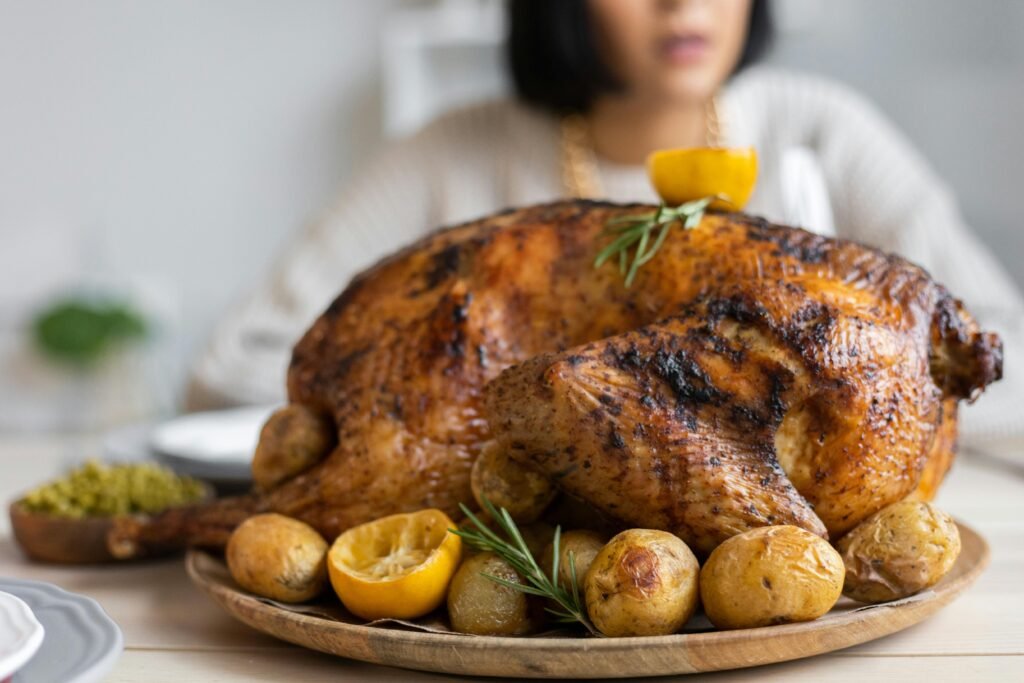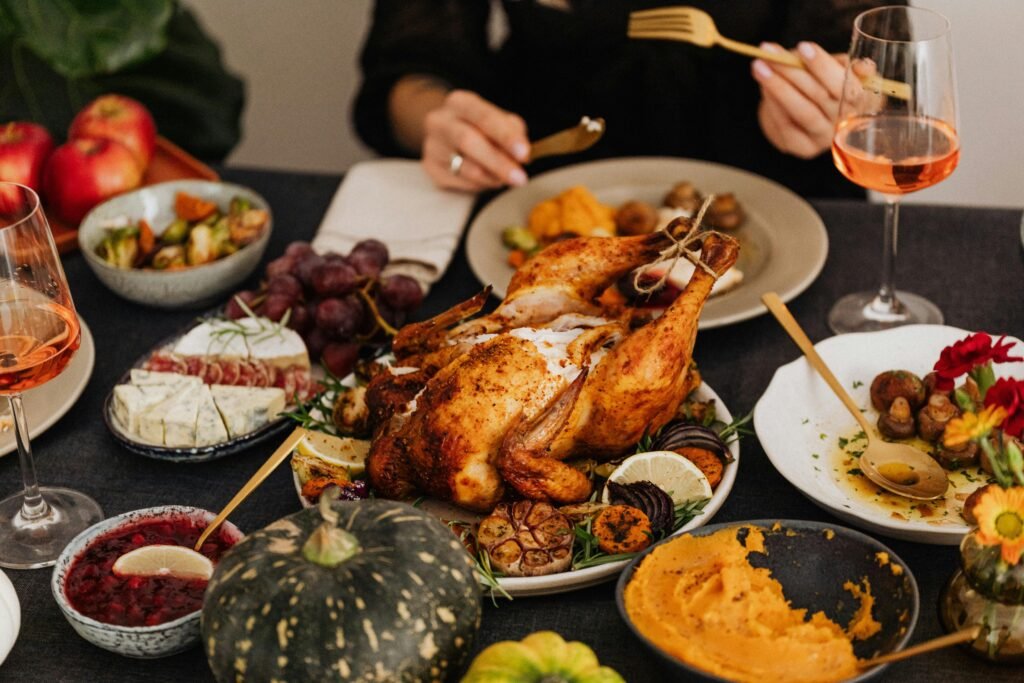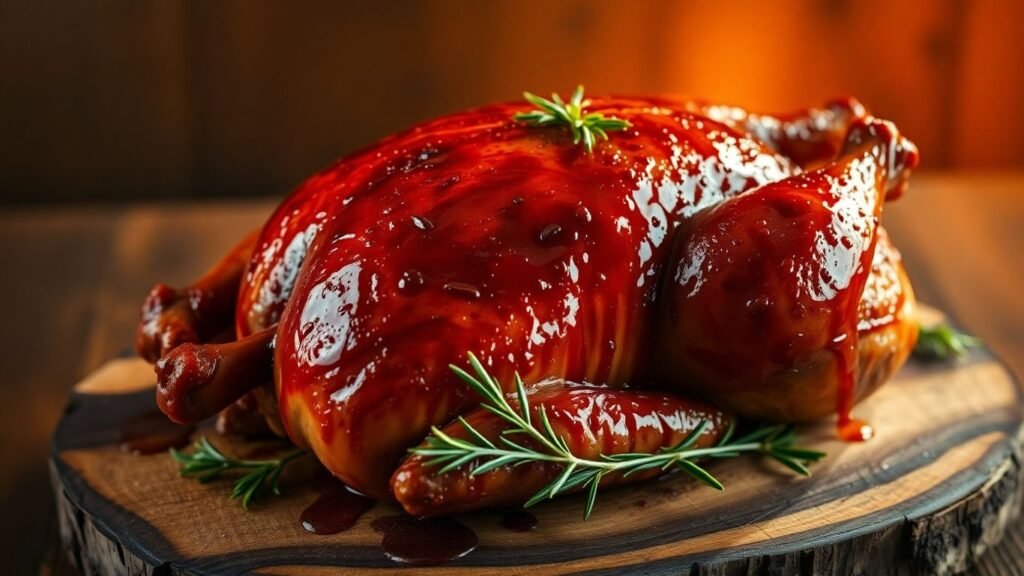Making a truly tender and delicious smoked-turkey at home can seem a bit daunting, but honestly, it’s pretty straightforward once you break it down. We’re talking about getting that perfect balance of smoky flavor with a sweet, sticky glaze that just melts in your mouth. Forget those dry, bland birds of the past; this guide is all about achieving a juicy, flavorful smoked-turkey that’ll be the star of any meal. From picking the right cut of meat to getting that final glaze just right, we’ll walk through each step to make sure your smoked-turkey turns out amazing.
Key Takeaways
- Start with a good quality boneless turkey breast, and avoid any that are pre-flavored.
- A simple rub with brown sugar, salt, and paprika helps season the meat and adds color.
- Maintain a consistent smoker temperature around 225°F for that low-and-slow cooking process.
- The honey glaze, made with honey, brown sugar, and a touch of Dijon, adds a wonderful sweet and tangy finish.
- Using a thermometer to check the internal temperature and letting the smoked-turkey rest are vital for a tender result.
Selecting The Perfect Turkey Breast
Alright, let’s talk turkey breast. Picking the right one is the first step to getting that super tender, honey-glazed smoked bird we’re aiming for. It might seem simple, but there are a few things to keep in mind.
Choosing Boneless Turkey Breast
For this recipe, we’re going with a boneless turkey breast. It’s just easier to handle and cook evenly, especially when you’re aiming for that perfect texture. You’ll often find them sold as a “roast,” which is usually a couple of smaller breasts tied together with netting. That’s totally fine, and actually makes for a nice, cohesive piece once it’s cooked.
Understanding Turkey Breast Roasts
When you grab a turkey breast roast from the store, take a peek at the packaging. You want to avoid any that already have added flavors or marinades. Things like “Cajun seasoned” or “herb-infused” might sound good for other dishes, but for our honey-glazed smoked turkey, they can mess with the delicate balance of our rub and glaze. Stick to plain, unadulterated turkey breast.
Avoiding Pre-Flavored Turkey
This ties into the last point. It’s really important to grab a plain turkey breast. Sometimes, you’ll see them labeled as “enhanced” or “injected with a solution.” While this can make turkey moist, it also adds salt and other things that might not play well with our planned seasonings. It’s best to start with a blank canvas so you control all the flavors.
Here’s a quick rundown of what to look for:
- Look for “Plain” or “Unseasoned”: This is your golden rule.
- Check the Ingredients: If you see more than just turkey and maybe water or salt, put it back.
- Boneless is Best: For ease of cooking and slicing.
Starting with a good quality, plain turkey breast means you’re setting yourself up for success. It allows the smoke, the rub, and the glaze to really shine through without any competing flavors.
Mastering The Smoked-Turkey Rub

Alright, let’s talk about the rub. This is where you really start building flavor for your smoked turkey breast. It’s not just about throwing some spices on; it’s about creating a base that complements the smoke and the eventual glaze. Think of it as the foundation for a really tasty bird.
Creating A Sweet And Savory Rub
For a good rub, you want a balance. Too much salt and it’ll be overpowering, too little and it won’t do much. A common starting point is brown sugar for sweetness and kosher salt for seasoning. I like to use dark brown sugar because it has a bit more moisture and a deeper molasses flavor, which works well with smoke. You can also add things like garlic powder, onion powder, and a touch of black pepper for a little kick. The key is to mix these ingredients well so you get an even distribution of flavor when you apply it.
Here’s a simple mix to get you started:
| Ingredient | Amount |
|---|---|
| Dark Brown Sugar | 2 tablespoons |
| Kosher Salt | 4 teaspoons |
| Black Pepper | 1 teaspoon |
| Garlic Powder | 1 teaspoon |
| Onion Powder | 1 teaspoon |
The Role Of Paprika For Color
Paprika is a bit of a secret weapon in rubs, especially for smoked meats. It doesn’t add a ton of flavor, though some varieties can be smoky or sweet. Its main job here is color. A good amount of paprika, especially smoked paprika, will give your turkey a beautiful, deep reddish-brown hue as it cooks. It makes the finished product look really appealing, like it came straight from a fancy deli counter.
Allowing The Rub To Brine The Turkey
This is a step that can make a big difference in moisture and flavor. Once you’ve applied the rub all over the turkey breast, wrap it tightly in plastic wrap. Then, let it sit in the refrigerator for at least 8 hours, or even up to 24 hours. This process is similar to a dry brine. The salt in the rub will start to draw out some moisture from the turkey, dissolve into that moisture, and then get reabsorbed back into the meat. This helps to season the turkey all the way through and can also help it retain more moisture during the smoking process. It’s a little bit of extra time, but it’s worth it for that tender, flavorful result.
Don’t be afraid to really get the rub into every nook and cranny. The more surface area you cover, the more flavor you’ll get. Just make sure your hands are clean before and after!
Achieving Optimal Smoking Temperature
Getting the temperature right in your smoker is pretty important for that tender, juicy turkey. Too hot, and you risk drying out the meat before it’s cooked through. Too low, and you’ll be waiting forever, and the smoke might not penetrate the way you want it to.
Preheating Your Smoker
Before you even think about putting the turkey in, you need to get your smoker up to temperature. This usually means firing it up about 20-30 minutes beforehand. You want a stable heat source so the cooking process is consistent from the start. Think of it like preheating your oven – it makes a big difference.
Selecting The Right Smoking Wood
The type of wood you use really impacts the flavor. For turkey, milder woods work best. Think about fruitwoods like apple or cherry, or even a bit of pecan. These give a gentle smoke that complements the poultry without overpowering it. Avoid strong woods like hickory or mesquite for turkey, as they can be a bit too much.
- Applewood: Sweet and mild, great for poultry.
- Cherrywood: Slightly sweet, produces a nice reddish smoke.
- Pecan: Nutty and mild, a good all-around choice.
Maintaining A Consistent 225°F
For that perfect tender smoked turkey, the sweet spot for your smoker temperature is generally around 225°F. This low and slow approach allows the connective tissues in the turkey to break down gradually, resulting in a moist and tender product. It also gives the smoke time to really infuse the meat with flavor. You’ll want to keep an eye on your smoker’s thermometer and adjust vents or add fuel as needed to keep that temperature steady. It might take a little practice, but a consistent temperature is key.
Keeping your smoker at a steady 225°F is the goal. This temperature allows the smoke to work its magic and the turkey to cook through gently, preventing it from drying out. It’s a balance between cooking time and flavor development.
Crafting The Irresistible Honey Glaze

Balancing Sweetness With Dijon
Alright, so you’ve got your turkey prepped and smoking away. Now, let’s talk about that glaze. This is where the magic really happens, turning a good smoked turkey into something truly special. We’re aiming for a balance, you know? Too sweet and it’s cloying, but too much tang and it just doesn’t feel like a treat. That’s where Dijon mustard comes in. It’s not just about adding a little kick; it cuts through the sweetness of the honey and butter, giving the glaze a bit of complexity. Think of it as the supporting actor that makes the star shine even brighter. A tablespoon or so is usually plenty to get that nice contrast without making the glaze taste like mustard.
Achieving The Perfect Glaze Consistency
Getting the glaze consistency right is key. You don’t want it too thin, or it’ll just run off the turkey and pool in the bottom of your smoker. On the other hand, if it’s too thick, it can get a bit gummy. We’re looking for something that coats the back of a spoon nicely, like a thin syrup. To get there, you’ll typically combine your honey and butter in a saucepan over medium heat. Once it’s melted and combined, you’ll add your Dijon and any other liquids. Let it simmer for a few minutes until it thickens just a bit. It should still be pourable but have some body to it. Remember, it will thicken more as it cools.
Incorporating Wine Or Broth For Depth
Want to give your glaze even more flavor? Adding a splash of liquid can really make a difference. White wine is a popular choice because its acidity complements the sweetness and richness of the glaze. A dry white wine, like a Sauvignon Blanc or Pinot Grigio, works well. If you’re not a fan of wine or prefer not to use it, chicken, turkey, or even vegetable broth are great substitutes. They add a savory note that deepens the overall flavor profile without adding any unwanted sweetness. Just a couple of tablespoons should do the trick to add that extra layer of taste.
The Smoking And Glazing Process
Alright, so you’ve got your turkey prepped and your smoker fired up. Now comes the fun part: turning that seasoned bird into a smoky masterpiece. It’s a two-stage process, really. First, we let the smoke work its magic, and then we add that sweet, sticky glaze.
Initial Smoking Of The Turkey
Get your smoker to a steady 225°F. Once it’s there, toss in your chosen smoking wood chunks – apple or cherry are great choices for turkey, giving it a nice, mild flavor. When the wood starts smoking well, it’s time to place the turkey breast in the smoker. You want to let it smoke undisturbed for about an hour and a half, or until the internal temperature hits around 140°F. This is when the meat really starts to absorb that smoky goodness.
Applying The Honey Glaze
While the turkey is smoking away, whip up your glaze. You’ll want to combine your maple syrup, brown sugar, and Dijon mustard in a small pot. Heat it gently, bringing it to a boil, then reduce the heat and let it simmer for about five to ten minutes until it thickens up just a bit. You don’t want it too thin, or it’ll just run off. Once the turkey reaches that 140°F mark, pull it out and give it a good brush with the glaze. Don’t be shy! Reheat the glaze if it’s cooled too much. Then, pop it back in the smoker.
Finishing The Smoked-Turkey
After you’ve applied the glaze, continue smoking the turkey. You’re looking for the internal temperature to reach 155°F in the thickest part of the breast. This usually takes another 30 to 60 minutes. Keep an eye on it; you don’t want to overcook it. Once it hits that target temperature, carefully remove the turkey from the smoker. Let it rest for about 10 minutes before you do anything else. This short rest helps the juices redistribute, making for a more tender bite.
Remember, the goal is a moist, flavorful turkey with a beautiful, slightly sticky exterior. Patience during the smoking and glazing stages really pays off here.
Ensuring A Tender Smoked-Turkey

Getting that perfect, tender smoked turkey isn’t just about the smoke and the glaze; it’s really about knowing when it’s done and how to treat it afterward. You don’t want to pull it too early and have it be undercooked, or leave it in too long and end up with dry, tough meat. It’s a bit of a balancing act.
Using An Instant-Read Thermometer
This is your best friend for knowing exactly when your turkey is ready. Forget those old pop-up timers; they’re not very accurate. An instant-read thermometer gives you a precise temperature reading right in the thickest part of the meat, avoiding the bone. For smoked turkey breast, you’re generally aiming for an internal temperature of around 155°F (68°C). Pulling the turkey off the heat just a few degrees before it hits the target is key, as it will continue to cook a bit while it rests.
Here’s a quick guide to target temperatures:
| Part of Turkey | Target Temperature (°F) |
|---|---|
| Thickest Part | 155°F (68°C) |
Resting The Turkey After Smoking
Once your turkey hits that magic 155°F, don’t just slice into it immediately. You need to let it rest. This is a super important step that lets the juices redistribute throughout the meat. If you cut it too soon, all those delicious juices will run out onto your cutting board, leaving you with dry turkey. Tent it loosely with foil and let it sit for at least 10-15 minutes. Seriously, don’t skip this part. It makes a huge difference in how moist the final product is.
Slicing For Optimal Texture
How you slice your turkey also plays a role in its tenderness. Always slice against the grain of the meat. You can usually see the direction the muscle fibers are running. Cutting across these fibers shortens them, making each bite feel more tender. If you slice with the grain, the meat can feel stringy and tougher, even if it was cooked perfectly. Use a sharp knife for clean cuts; a dull knife can tear the meat and make it look messy.
Storing And Reheating Your Smoked-Turkey

So, you’ve got this amazing honey-glazed smoked turkey, and now you’re wondering how to keep it tasting great for later. It’s not too tricky, really. The key is to handle it right after it cools down a bit.
Refrigerating Leftovers
Once your turkey has cooled down to room temperature, it’s time to get it into the fridge. Don’t leave it sitting out for too long; food safety first, you know? Wrap it up well. You can use plastic wrap, foil, or even put it in an airtight container. Keeping it sealed helps prevent it from drying out and picking up any weird fridge smells. If you have any leftover juices from resting, try to get those in with the turkey; they’re gold for keeping it moist later.
Freezing For Future Enjoyment
Got a ton of turkey and don’t think you’ll get through it in a few days? Freezing is your friend. Slice the turkey first. This makes it way easier to thaw and use smaller portions later. Wrap each portion tightly in plastic wrap, then maybe add a layer of foil or pop it into a freezer bag. This double-wrapping is a good idea to stop freezer burn. Properly wrapped, your smoked turkey can hang out in the freezer for a good couple of months and still be pretty tasty.
Reheating Methods For Best Results
Reheating is where you can really mess it up if you’re not careful, turning that tender meat into something dry and sad. The oven is usually the best bet. Slice the turkey, and if you have those reserved juices, pour a little over the slices. Cover the dish with foil – this is important! You want to gently warm it through, not blast it with heat. A temperature around 300°F (150°C) is usually good. It might take about 10-20 minutes depending on how much you’re reheating. Avoid the microwave if you can, as it tends to make the meat a bit rubbery. If you’re in a real pinch, a quick zap in the microwave is okay, but do it on a lower power setting and don’t overheat it. For a really nice touch, you can even add a splash of chicken broth or water to the dish before reheating to add back some moisture. Check out these reheating tips for more ideas.
Enjoy Your Tender, Glazed Turkey!
So there you have it. You’ve put in the time, and now you’ve got a beautiful, tender, honey-glazed smoked turkey ready to impress. Whether it’s for a special occasion or just a really nice weekend meal, this turkey is sure to be a hit. Don’t be surprised if people ask for the recipe – it’s that good. Enjoy every juicy bite!
Frequently Asked Questions
What kind of turkey breast is best for smoking?
For the most tender and juicy smoked turkey, it’s best to pick a boneless turkey breast. Make sure it doesn’t already have added flavors like herbs or spices, as this can mess with the rub and glaze you’ll be using.
How do I get a good smoky flavor?
The type of wood you use in your smoker makes a big difference! Woods like apple or cherry give a nice, mild, fruity smoke that works wonderfully with turkey. Make sure your smoker is hot and producing good smoke before you put the turkey in.
Can I make the honey glaze ahead of time?
Yes, you can prepare the glaze ingredients ahead of time and store them. However, it’s best to cook the glaze right before you plan to use it on the turkey to ensure it has the perfect consistency.
How do I know when the turkey is cooked?
The best way to tell if your turkey is ready is by using a meat thermometer. Stick it into the thickest part of the breast. It should reach about 165°F for perfectly cooked, tender turkey.
Why is resting the turkey important?
Letting the turkey rest after smoking allows the juices to settle back into the meat. If you slice it right away, all those delicious juices will run out, leaving you with drier turkey. Resting for about 10-15 minutes is usually enough.
How should I store leftover smoked turkey?
Once the turkey has cooled down, store any leftovers in an airtight container in the refrigerator. It should stay good for about 3-4 days. You can also freeze it for longer storage, up to 3 months.


